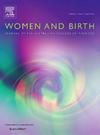Do migrant women have equity of access to midwife continuity of care?
IF 4.1
2区 医学
Q1 NURSING
引用次数: 0
Abstract
Background
Migrant populations are recognised to be at increased risk of adverse health outcomes including perinatal outcomes. Structural barriers to maternity care and racism are recognised globally as an urgent issue for migrants. Midwife continuity of care (MCoC) has well known improved perinatal benefits.
Aim
To investigate if duration since migration was associated with reduced access to MCoC.
Methods
We conducted a retrospective cohort study from June 2020–November 2023 at six Australian hospitals. MCoC was investigated by hospital and self-identified ethnic group for women who migrated < 5 years, ≥ 5 years compared to the Australian born population. Regression models adjusted for significant factors including use of interpreter and co-morbidities.
Findings
There were 48,240 participants for analysis. Most in the cohort were Australian born (54.7 %, n = 26,365), migrants of < 5 years comprised 13.2 % (n = 6388) and those who migrated ≥ 5 years 32.1 % (n = 15,487). At all study hospitals, new migrants had the least access to MCoC. Compared to Australian born women, new migrants were 70 % less likely to receive MCoC (aOR 0.30; 95 %CI 0.27–0.34) and migrants of ≥ 5 years were 49 % less likely (aOR 0.51; 95 %CI 0.48–0.56). We identified a difference to access to MCoC between ethnic groups.
Discussion
Health literacy needs of women who are migrants should be addressed to improve equity of access to a model of care that is evidenced based to improve perinatal outcomes.
Conclusion
It is incumbent on health services to measure equity of access and adjust services to ensure equity of access for all populations.
移徙妇女是否有平等的机会获得助产士的持续护理?
背景:人们认为,移民人口出现不良健康结果(包括围产期结果)的风险更高。产妇保健的结构性障碍和种族主义是全球公认的移民面临的紧迫问题。众所周知,助产士连续性护理(MCoC)改善了围产期的益处。目的调查迁移后的持续时间是否与MCoC的获取减少有关。方法:我们于2020年6月至2023年11月在澳大利亚6家医院进行了一项回顾性队列研究。对移居<; 5年,与澳大利亚出生人口相比≥ 5年的妇女进行医院和自我认同的族裔群体的MCoC调查。回归模型调整了包括口译员使用和合并症在内的重要因素。研究结果共有48240名参与者参与了分析。大多数在澳大利亚出生队列(54.7 % n = 26365),移民& lt; 5年由13.2 % (n = 6388)和那些迁移≥5年 32.1 % (n = 15487)。在所有研究医院中,新移民获得MCoC的机会最少。与澳大利亚出生的女性相比,新移民接受MCoC的可能性低70% % (aOR 0.30;95 %CI 0.27-0.34),≥ 年的迁移者的可能性降低49 % (aOR 0.51;95 %可信区间0.48 - -0.56)。我们确定了不同种族群体获得MCoC的差异。讨论应解决移徙妇女的卫生知识普及需求,以改善公平获得以改善围产期结局为基础的循证护理模式的机会。结论卫生服务机构有责任衡量可及性的公平性并调整服务,以确保所有人群可及性的公平性。
本文章由计算机程序翻译,如有差异,请以英文原文为准。
求助全文
约1分钟内获得全文
求助全文
来源期刊

Women and Birth
NURSING-OBSTETRICS & GYNECOLOGY
CiteScore
7.20
自引率
13.20%
发文量
371
审稿时长
27 days
期刊介绍:
Women and Birth is the official journal of the Australian College of Midwives (ACM). It is a midwifery journal that publishes on all matters that affect women and birth, from pre-conceptual counselling, through pregnancy, birth, and the first six weeks postnatal. All papers accepted will draw from and contribute to the relevant contemporary research, policy and/or theoretical literature. We seek research papers, quality assurances papers (with ethical approval) discussion papers, clinical practice papers, case studies and original literature reviews.
Our women-centred focus is inclusive of the family, fetus and newborn, both well and sick, and covers both healthy and complex pregnancies and births. The journal seeks papers that take a woman-centred focus on maternity services, epidemiology, primary health care, reproductive psycho/physiology, midwifery practice, theory, research, education, management and leadership. We also seek relevant papers on maternal mental health and neonatal well-being, natural and complementary therapies, local, national and international policy, management, politics, economics and societal and cultural issues as they affect childbearing women and their families. Topics may include, where appropriate, neonatal care, child and family health, women’s health, related to pregnancy, birth and the postpartum, including lactation. Interprofessional papers relevant to midwifery are welcome. Articles are double blind peer-reviewed, primarily by experts in the field of the submitted work.
 求助内容:
求助内容: 应助结果提醒方式:
应助结果提醒方式:


